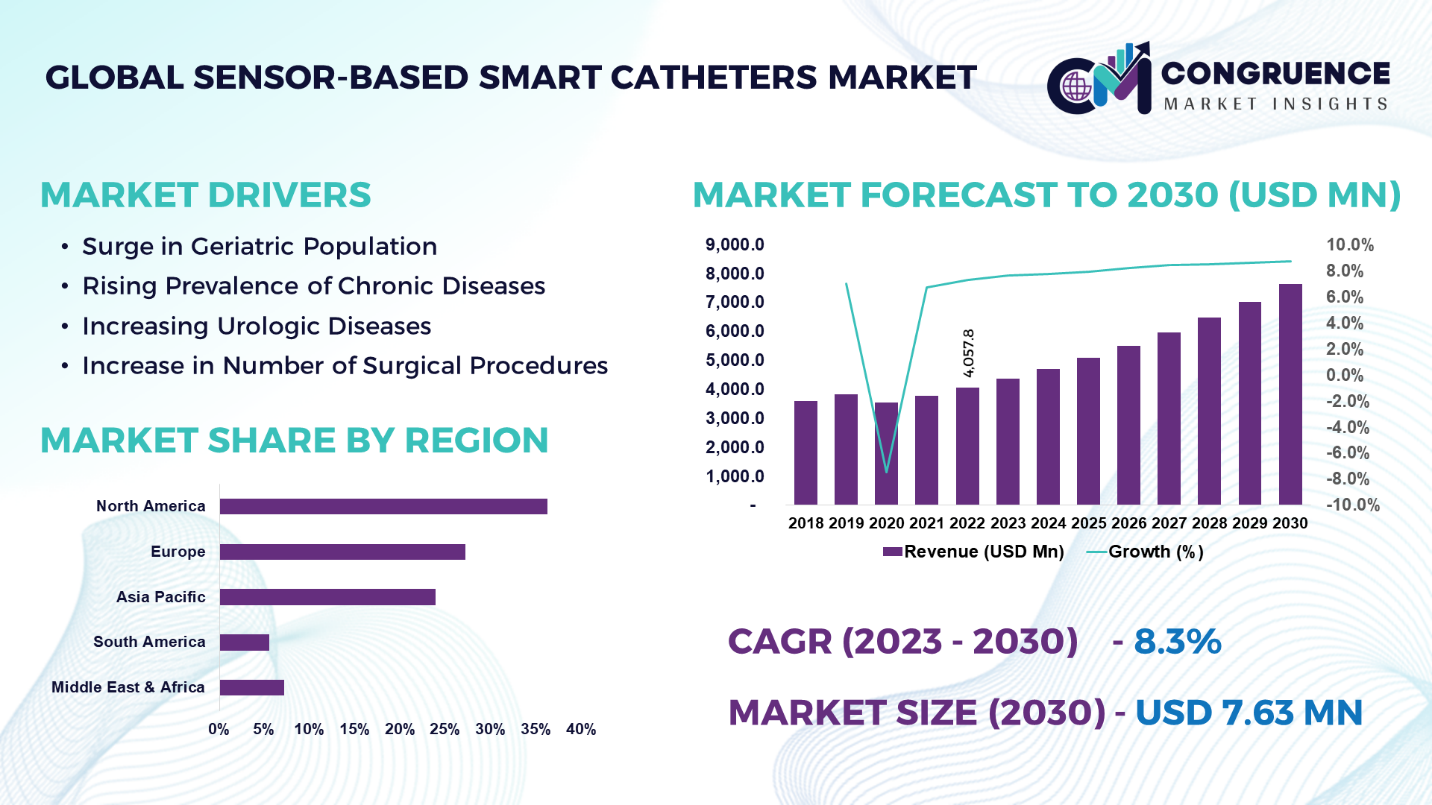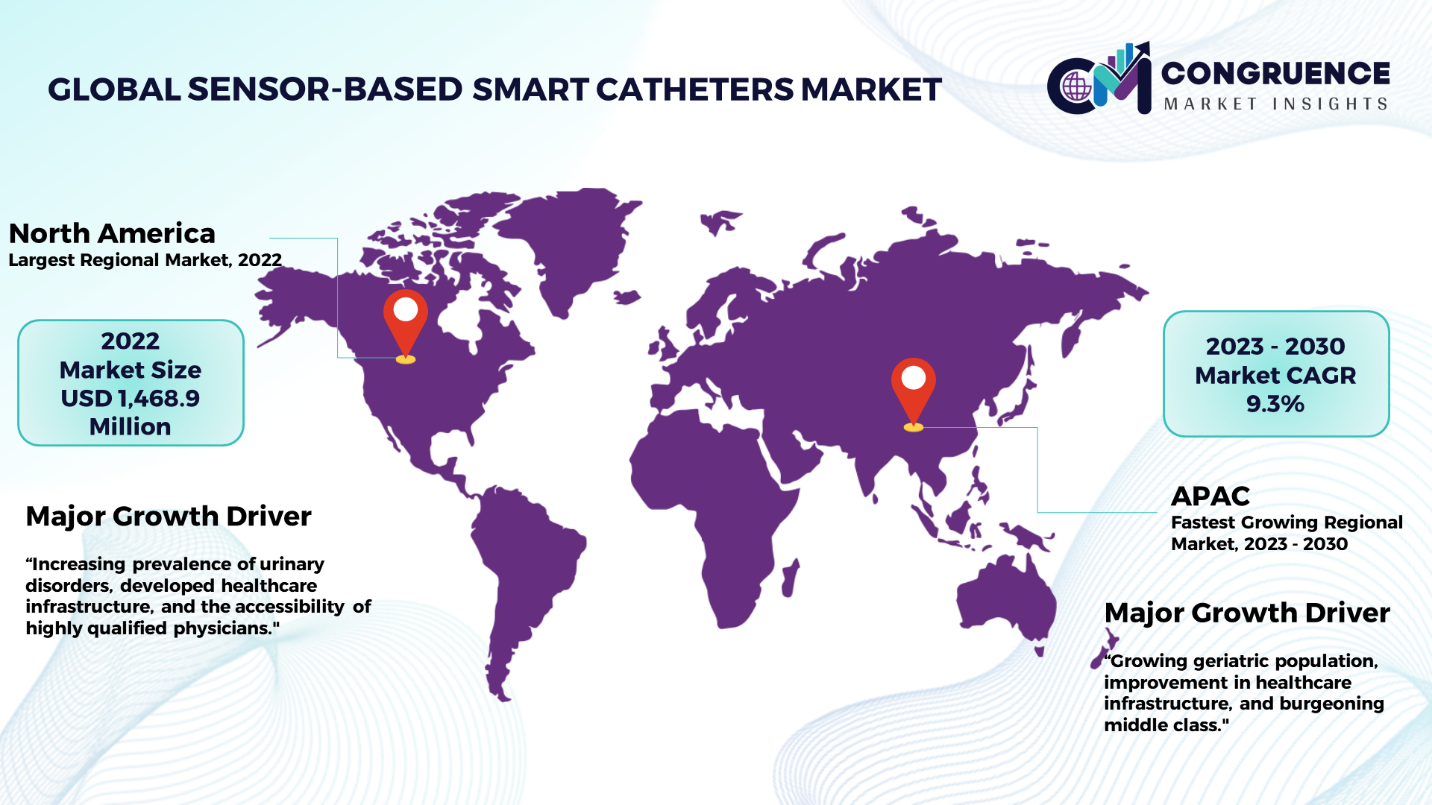Reports
The Global Sensor-based Smart Catheters Market was valued at USD 4,057.8 Million in 2022 and is anticipated to reach a value of USD 7,626.7 Million by 2030 expanding at a CAGR of 8.3% between 2023 and 2030.
A sensor-based smart catheter detects chemical changes in the pH or acid-base environment around the catheter. These smart catheters are advanced medical device designed for diagnostic and therapeutic procedures. These catheters are integrated with sensor technology to enhance their performance, allowing for real-time monitoring with improved accuracy. Sensor-based smart catheters are equipped with sensors that can detect and measure various function within our body. These sensors include imaging sensors, pressure sensors, temperature sensors, and other type of sensors depending upon the required applications. Based on type, these catheters can be classified into temperature sensing foley catheter, pressure catheter, mapping catheter, and others. The sensor-based smart catheters market finds applications in various medical fields, including cardiovascular, urology, gynecology, neurovascular, and others. The surge in geriatric population, rising prevalence of chronic diseases, increasing urologic diseases, and increase in number of surgical procedures have fueled the demand for sensor-based smart catheters.

Sensor-based Smart Catheters Market Major Driving Forces
Surge in Geriatric Population: The increasing geriatric population is the significant driver of sensor-based smart catheters market. The rising geriatric population leading to an increased incidence of health issues such as cardiovascular diseases, urological disorders, and other diseases drives the demand for sensor-based smart catheters.
Rising Prevalence of Chronic Diseases: The increasing number of chronic diseases such as cardiovascular diseases, neurovascular disorders, and urological condition have led to an increase in minimally invasive procedures. Rising prevalence of chronic diseases fuels the demand for sensor-based smart catheters.
Increasing Urologic Diseases: Rise in incidence of urologic diseases such as urine retention, bladder blockage, urinary tract infection (UTI), and urinary diseases drives the demand for sensor-based smart catheters. Therefore, plyers are increasingly carrying out research on smart catheter flow sensors.
Increase in Number of Surgical Procedures: Due to the rise in number of surgical procedures, demand for sensor-based smart catheters have been increased significantly. Owing to the surge in incidence of various chronic diseases and growth in number of ICU admissions, the demand for sensor-based smart catheters is increased.
Sensor-based Smart Catheters Market Key Opportunities
Technological Advancements: Ongoing advancements in sensor technologies including miniaturization, improved accuracy, and wireless connectivity have enabled the integration of sensors into catheters. This integration allowing real-time monitoring and improved diagnostic capabilities, which further create an opportunity for market growth.
Increasing Demand for Remote Monitoring:
The rising demand for remote patient monitoring and telemedicine offers lucrative opportunities for sensor-based smart catheters market. Smart catheters can transmit real-time data to healthcare providers, enabling them remote monitoring and timely interventions. Integrating smart catheters can enable remote monitoring and improve patient care which reduces healthcare costs.
Expansion in Emerging Markets:
Expansion into emerging economies, characterized by growing healthcare infrastructure, and increasing healthcare expenditure creates an opportunity for sensor-based smart catheters market growth. Market major players can expand their global reach in emerging regions by offering innovative and cost-effective products.
Sensor-based Smart Catheters Market Key Trends
· Rising demand for minimally invasive procedures leading to development of advanced catheters with sensor-based technology
· Increasing focus on the integration of sensors with robotics and artificial intelligence to enhance catheter performance and diagnostic capabilities
· Increasing incidence of chronic diseases such as cardiovascular diseases, urologic diseases, and neurovascular disorders have led to increase in demand or minimally invasive procedures
· Growing aging population leading to an increased incidences of health issues, which fuel the demand for sensor-based catheters
· Advancements in sensor technology such as miniaturization, improved accuracy, and wireless connectivity accelerating the growth of the market
· The integration of wireless connectivity in sensor-based smart catheters enables real-time data transmission and data analytics for better decision-making
· Market players are developing sensor-based smart catheters tailored for specific requirements, which offer specialized features and functionalities
Region-wise Market Insights
North America accounted for the largest market share at 36.2% in 2022 whereas, Asia Pacific is expected to register the fastest growth, expanding at a CAGR of 9.3% between 2023 and 2030.

North America led the market due to advanced healthcare infrastructure and the presence of strong patient base with kidney and cardiovascular diseases within region. In North America, the demand is driven by increasing prevalence of urinary disorders, developed healthcare infrastructure, and the accessibility of highly qualified physicians in the region. In Europe, the growth is attributed to the rising disposable income, growing healthcare demand, and growing aging population in the region. In Asia-Pacific, the market is characterized by growing geriatric population, improvement in healthcare infrastructure, and burgeoning middle class which has created an increasing demand for sensor-based smart catheters. Additionally, increasing government policies, innovation in the field, new product launches are also anticipated to drive the market in Asia Pacific region. The Middle East and Africa has been witnessing a growing demand for sensor-based smart catheters due to rising healthcare investments, healthcare infrastructure development, and growing awareness of advanced healthcare technologies in the region.
Market Competition Landscape
The global sensor-based smart catheters market is characterized by high degree of competition with several key players striving to strengthen their position in market. Major players in the market are heavily investing in research and development to provide innovative and reliable solutions. These companies are focused on product development, research and development investments, and strategic partnerships with other organizations to meet the changing needs of healthcare professionals and improve patient care. Key players in the sensor-based smart catheters market engage in strategies aimed at gaining a competitive edge. These strategies include product innovation, design differentiation, and the incorporation of sustainable and eco-friendly materials to meet evolving consumer preferences. Established brands leverage their reputation for quality and reliability to maintain market share, while newer entrants focus on disruptive innovations and unique selling propositions.
Key players in the global sensor-based smart catheters market implement various organic and inorganic strategies to strengthen and improve their market positioning. Prominent players in the market include:
· Abbott Laboratories
· Johnson & Johnson Services, Inc.
· ICU Medical, Inc.
· Becton, Dickinson and Company.
· Medtronic plc
· Boston Scientific Corporation
· Siemens Healthineers
· Teleflex Incorporated
· Biometrix Corporation
· B. Braun SE
· ADInstruments
· Philips Healthcare
· UroDev Medical.
· ASID BONZ GmbH
|
Report Attribute/Metric |
Details |
|
Market Revenue in 2022 |
USD 4,057.8 Million |
|
Market Revenue in 2030 |
USD 7,626.7 Million |
|
CAGR (2023 – 2030) |
8.3% |
|
Base Year |
2022 |
|
Forecast Period |
2023 – 2030 |
|
Historical Data |
2018 to 2022 |
|
Forecast Unit |
Value (US$ Mn) |
|
Key Report Deliverable |
Revenue Forecast, Growth Trends, Market Dynamics, Segmental Overview, Regional and Country-wise Analysis, Competition Landscape |
|
Segments Covered |
· By Product Type (Temperature Sensing Foley Catheter, Pressure Catheter, Mapping Catheter, and Others) · By Catheter Type (Single Lumen, and Multi Lumen) · By Material Type (Silicon, Polytetrafluoroethylene, Polyetheretherketone, and Others) · By Application (Cardiovascular, Urology, Gynecology, Neurovascular, and Others) |
|
Geographies Covered |
North America: U.S., Canada and Mexico Europe: Germany, France, U.K., Italy, Spain, and Rest of Europe Asia Pacific: China, India, Japan, South Korea, Southeast Asia, and Rest of Asia Pacific South America: Brazil, Argentina, and Rest of Latin America Middle East & Africa: GCC Countries, South Africa, and Rest of Middle East & Africa |
|
Key Players Analyzed |
Abbott Laboratories, Johnson & Johnson Services, Inc., ICU Medical, Inc., Becton, Dickinson and Company., Medtronic plc., Boston Scientific Corporation, Siemens Healthineers, Teleflex Incorporated, Biometrix Corporation, B. Braun SE, ADInstruments, Philips Healthcare, UroDev Medical., and ASID BONZ GmbH. |
|
Customization & Pricing |
Available on Request (10% Customization is Free) |
